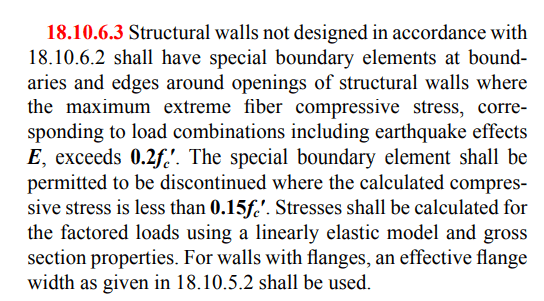BradGile
Structural
- Sep 24, 2020
- 3
Can anyone please help me understand the force-based boundary element requirement from ACI 318 shown as below?
My questions are as below,
1. Why do we use the gross section properties to determine the extreme fiber compressive stress even if the extreme fiber tensile stress is greater than the tensile strength of concrete, causing the concrete to cracked and making the extreme fiber compressive stress to further increase? Is this why the limit 0.2fc instead of fc?
2. What happens if the moment is so small that the section is fully in compression, does 0.2fc still apply in this case and why? i.e. Is boundary element required as long as N* is greater 0.2fcAg then?
Thank you.

My questions are as below,
1. Why do we use the gross section properties to determine the extreme fiber compressive stress even if the extreme fiber tensile stress is greater than the tensile strength of concrete, causing the concrete to cracked and making the extreme fiber compressive stress to further increase? Is this why the limit 0.2fc instead of fc?
2. What happens if the moment is so small that the section is fully in compression, does 0.2fc still apply in this case and why? i.e. Is boundary element required as long as N* is greater 0.2fcAg then?
Thank you.

